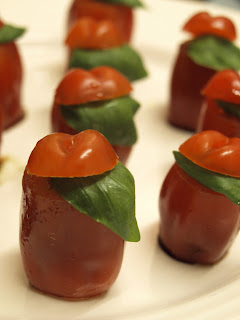
Now I know it’s the middle of summer in the northern hemisphere, but it’s a dismal, grey, rain-drenched day in London and I felt like indulging in a hot chocolate in August – just because I can – and because I have such a fine selection of chocolates from which to choose.
During my visit to Sicily in December 2006, I was surprised to discover that Sicilians preserve the Mexican way of making hot chocolate, a process that was brought over to Sicily by the Spanish when they controlled southern Italy in the 1700s. The town of
Modica (a World Heritage site) has grasped hold of this tradition and made it theirs, effectively using it to market their town to tourists. The main street, Corso Umberto, is lined with chocolate shops and
pasticcierie (pastry shops, which in this case specialize in Sicilian delicacies).
The cocoa is combined with cane sugar crystals, often mixed with spices and made into a bar. You can then either eat it as is or, better still, melt it in a cup of warm milk on the stove and have a delightful hot chocolate that is just sweet enough, but not too much. It works to use 1 tablet of a chocolate bar per cup of milk, depending on size and how rich you want it. I let the milk warm up a bit first over a gentle flame and then add the bar, which should melt quickly. Stir it with a wooden spoon to break it apart. When it’s all melted, it’s ready to drink. Dolceria Bonajuto
Dolceria Bonajuto has been around since 1880 and is the oldest chocolate shop in Sicily. Walking into the shop is like walking back in time, or into the movie
Chocolat. Its glass cabinets are filled with exotic chocolate treats and the team is in the back, in white coats and caps, busily at work making more. I’ve just been drinking their chocolate with
nutmeg in it.
CioMod is a more modern affair with a classy shop on Corso Umberto. Not only do they sell traditional cioccolata modicana, but liquors and beauty products as well. I’ve held onto a chocolate bar with
ginger in it. On their website they advertise pure chocolate bars with cinnamon, vanilla, hot pepper, black tea, and coffee flavors, plus pure, plain chocolate and milk chocolate. I must say I like their packaging.
I picked up several bars in a café called
Bar del Viale, which is part of the Modica Chocolate Consortium. I’ve already consumed the
orange-flavored one, which was delicious, but I still have the
peperoncino (hot, red pepper flavor).
Finally, we also picked up some chocolate and other pastry treats in
Casa Don Puglisi, which employs women who have escaped abusive relationships. It helps get them back on their feet. I’ve still got a bar of their
anise-flavored chocolate, which I can’t wait to try (after all this time).
When I was home in California last December, my mom and I happened upon a Latin American grocery store in San Rafael. I came out with a container of
Chocolate Ibarra, Mexico’s most famous chocolate, which comes in round tablets and is flavored with cinnamon. It’s made just like the chocolate from Modica, but they add a bit of emulsifier. I also bought a 400 gram tablet of
Chocolate Guerrero, which seems like pretty much the same thing, but it has a bit of milk and it’s from Guatemala. I have yet to try it, but it smells delightful.
If you live in the States, especially in an area with lots of Latin Americans, you should be able to find this stuff with no problem at all. So how do you find it in the UK? I might try
Coolchile.com, they seem to stock Mexican drinking chocolate and they’ve also got a stall at
Borough Market. The street market in Brixton (Electric Avenue, next to the tube) has some Latin American shops as well and you might get lucky.
At any rate, it beats Cadbury’s and any sort of industrial hot chocolate mix hands down because it’s just chocolate, sugar and a bit of spice – no funny stuff!

P.S. I just discovered recently that Seeds of Change (a cool organization that seeks to promote biodiversity, based in New Mexico USA) sells
chocolate bars in the UK. The one I bought at Tesco was with orange and fig – one of the best chocolate bars I’ve had in a long time.















































